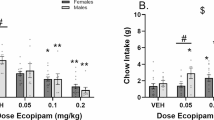Summary
Epinephrine and norepinephrine were infused continuously into the superior vena cava of the cat during the performance of an instrumental response. Both drugs depressed performance, epinephrine at 2 μg/kg/ minute and norepinephrine at 4 μg/kg/minute. Smaller doses produced no effect. With larger doses, the effect was practically idistinguishable from that obtained with intraventricular injections. It is concluded that the rates of infusion required to produce behavioral depression probably exceed the maximum rates of secretion of the adrenal medulla under physiological conditions, although the necessary level might be attained by endogenous catecholamines from other sources, including the brain itself. The possible sites of action are discussed.
Similar content being viewed by others
References
Axelrod, J., H. Weil-Malherbe and R. Tomchick: Physiological disposition of H3-adrenaline and its principal metabolite, metanephrine. Fed. Proc. 18, 364 (1959).
Becht, C.: Studies on the cerebrospinal fluid. Amer. J. Physiol. 51, 1–125 (1920).
Bonvallet, M., P. Dell and G. Hiebel: Tonus sympathique et activité électrique corticale. Electroenceph. clin. Neurophysiol. 6, 119–144 (1954).
Edwards, A. L.: Statistical methods for the behavioral sciences. New York: Rinehart 1954.
Euler, C. v., and U. Söderberg: The influence of hypothalamic thermoceptive structures on the electroencephalogram and gamma motor activity. Electroenceph. clin. Neurophysiol. 9, 391–408 (1957).
Euler, U. S. v., and B. Folkow: Einfluß verschiedener afferenter Nervenreize auf die Zusammensetzung des Nebennierenmarkinkretes bei der Katze. Naunyn Schmiedeberg's Arch. exp. Path. Pharmak. 219, 242–247 (1953).
Feldberg, W., and S. L. Sherwood: Injections of drugs into the lateral ventricle of the cat. J. Physiol. (Lond). 128, 148–167 (1954).
Frank, M. M., R. J. Wurtman, W. H. Morse and P. B. Dews: Behavioral effects of epinephrine and norepinephrine. Fed. Proc. 18, 390 (1959).
Gellhorn, E.: Physiological foundations of neurology and psychiatry. Minneapolis: University Minnesota Press 1953.
Hess, W. R.: The functional organization of the diencephalon, edit. by J. R. Hughes. New York: Grune & Stratton 1957.
Hoagland, H.: On the mechanism of tonic immobility in vertebrates. J. gen. Physiol. 11, 715–741 (1928).
Jones, R. T., and W. D. Blake: Dynamics of epinephrine distribution in the dog. Amer. J. Physiol. 193, 365–370 (1958).
Kosman, M. E., and R.W. Gerard: The effect of adrenaline on a conditioned avoidance response. J. comp. physiol. Psychol. 48, 506–508 (1955).
Leimdorfer, A., R. Arana and M. H. Hack: Hyperglycemia induced by the action of adrenalin on the central nervous system. Amer. J. Physiol. 150, 588–595 (1947).
Magoun, H. W., F. Harrison, J. R. Brobeck and S. W. J. Ranson: Activation of heat loss mechanisms by local heating of the brain. J. Neurophysiol. 1, 101–114 (1938).
Outschoorn, A. S.: The hormones of the adrenal medulla and their release. Brit. J. Pharmacol. 7, 605–615 (1952).
Rothballer, A. B.: Studies on the adrenaline-sensitive component of the reticular activating system. Electroenceph. clin. Neurophysiol. 8, 603–621 (1956). - The effects of catecholamines on the central nervous system. Pharmacol. Rev. 11, 491–541 (1959).
Satake, Y.: Secretions of adrenaline and sympathins. Tôhoku J. exp. Med. 60, Suppl., 2 (1954).
Sharpless, S. K., and H. Jasper: Habituation of the arousal reaction. Brain 79, 655–680 (1956).
Siegel, S.: Nonparametric statistics for the behavioral sciences. New York: McGraw-Hill (Book Comp.) 1956.
Symposium: Neuropharmacology, edit. by H. A. Abramson. New York: Josiah Macy jr. Foundation 1956.
Vogt, M.: The concentration of sympathin in different parts of the central nervous system under normal conditions and after the administration of drugs. J. Physiol. (Lond.) 123, 451–481 (1954).
Weber, H.: Über Anästhesie durch Adrenalin. Verh. dtsch. Ges. inn. Med. 21, 616–619 (1904).
Author information
Authors and Affiliations
Additional information
This work was reported at the Twenty-Ninth Annual Meeting of the Eastern Psychological Association, April, 1958. It was supported by National Science Foundation Grant G-4459, and carried out while the author was a senior postdoctoral fellow on Interdisciplinary Grant 2M-6418, National Institute of Mental Health, U. S. Public Health Service.
Rights and permissions
About this article
Cite this article
Sharpless, S. The effects of intravenous epinephrine and norepinephrine on a conditioned response in the cat. Psychopharmacologia 1, 140–149 (1959). https://doi.org/10.1007/BF00409113
Received:
Issue Date:
DOI: https://doi.org/10.1007/BF00409113




